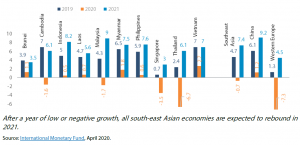Each of the 10 south-east Asian economies has its own vulnerabilities. As the wealthiest country in the region, Singapore has plenty of international reserves to spend its way out of the crisis. On the other hand, as a regional hub whose foreign trade was worth a colossal 326 % of GDP in 2018, it is uniquely dependent on international flows of goods, services and people, which have now been disrupted by the virus. In Thailand, the tourism sector, which is worth US$60 billion (over 10 % of GDP), is at an almost complete standstill. One in eight Philippine households depends on remittances from the country’s roughly 10-million strong diaspora, but as labour migrants lose their jobs, this source of income will dry up for many of them. Brunei’s hydrocarbon-driven economy will suffer from the global collapse of oil prices, while textile factories in Cambodia, Myanmar and Indonesia have laid off workers as international brands cancel orders due to a slump in demand.
Governments are planning huge spending increases in an attempt to avert economic catastrophe. Singapore’s stimulus package is the most generous: measures announced to date total over US$80 billion, equivalent to one-fifth of the country’s GDP. Malaysia plans to spend US$60 billion (about 17 % of GDP). The Thai package is worth US$64 billion (16 % of GDP), while Indonesia and Vietnam have allocated around 4 % of GDP. However, most of the remaining countries lack this kind of money, and their spending plans are much more modest, at 3 % of GDP or less.








Be the first to write a comment.